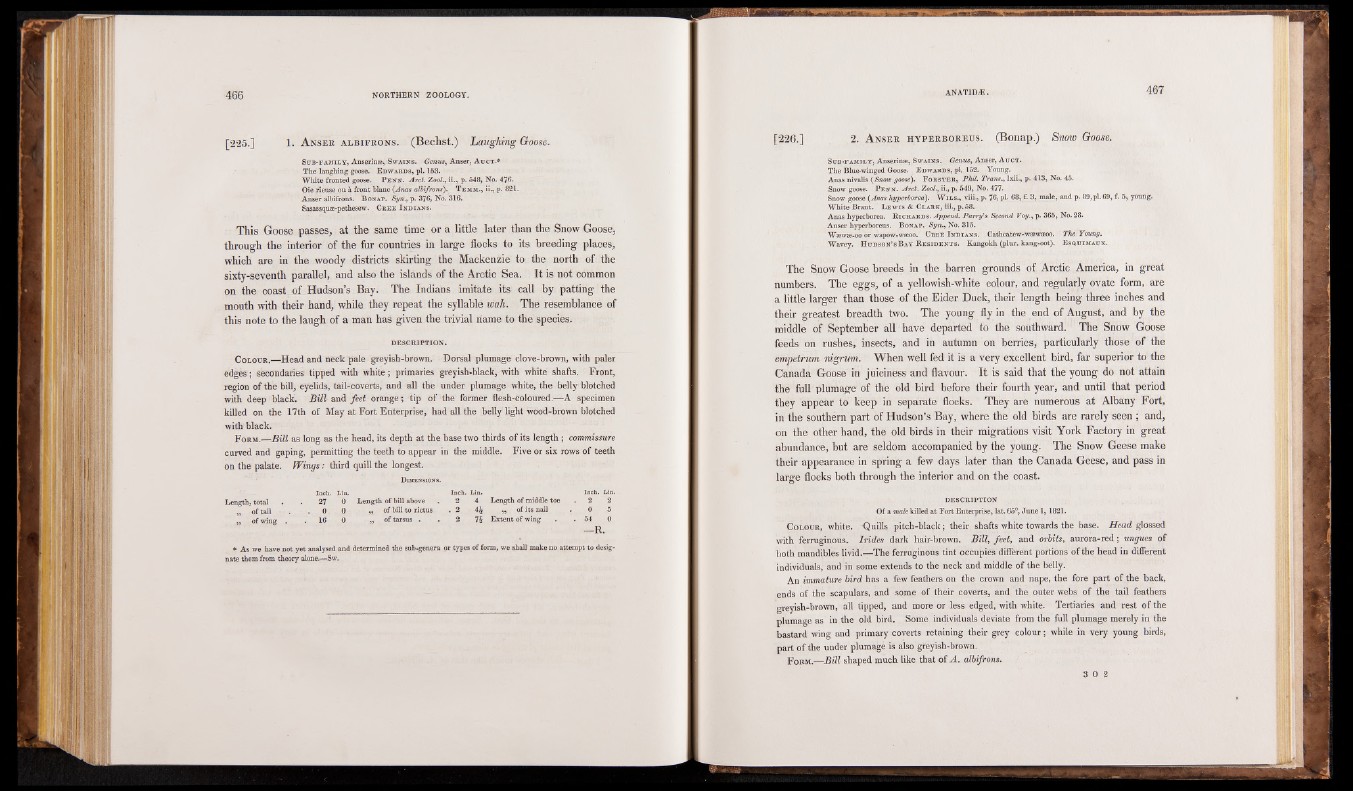
[225.] 1. Anser albiprons. (Bechst.) Laughing Goose.
Sub-family, Anserin®, Swains. Genus, Anser, Auct.*
The laughing goose. Edwards, pi. 153.
White fronted goose. P enn. Arct. Zool., ii., p. 548, No. 476.
Oie rieuse ou a front blanc (Anas albifrons). Temm., ii., p. 821.
A nser albifrons. B onap. Syn., p. 376, No. 316.
SasassquaB-pethesew. Cree I ndians.
This Goose passes, at the same time or a little later than the Snow Goose,
through the interior of the fur countries in large flocks to its breeding places,
which are in the woody districts skirting the Mackenzie to the north of the
sixty-seventh parallel, and also the islands of the Arctic Sea. It is not common
on the coast of Hudson’s Bay. The Indians imitate its call by patting the
mouth with their hand, while they repeat the syllable wah. The resemblance of
this note to the laugh of a man has given the trivial name to the species.
DESCRIPTION.
C olour.—Head and neck pale greyish-brown. Dorsal plumage clove-brown, with paler
edges; secondaries tipped with white; primaries greyish-black, with white shafts. Front,
region of the bill, eyelids, tail-coverts, and all the under plumage white, the belly blotched
with deep black. Bill and feet orange; tip of the former flesh-coloured.—A specimen
killed on the 17th of May at Fort Enterprise, had all the belly light wood-brown blotched
with black.
F orm.—Bill as long as the head, its depth at the base two thirds of its length ; commissure
curved and gaping, permitting the teeth to appear in the middle. Five or six rows of teeth
on the palate. Wings: third quill the longest.
Dimensions.
Inch. Lin. Inch. Lin. Inch. Lin.
Length, total . . 27 0 L ength of bill above . 2 4 Length of middle toe . 2 2
of tail • . . 0 0 - ,, of bill to rictus . 2 4£ .,, of its nail . 0 5
' of wing . . 16 0 „ of tarsus . . 2 7§ E xtent of wing . . 54 0 —R.
* A s we have not yet analysed and determined the sub-genera or types of form, we shall make no attem pt to designate
them from theory alone.—Sw.
[226.] 2. A n s e r h y p e r b o r e u s . (Bonap.) Snow Goose.
Sub-family, Anserinae, Swains. Genus, Anser, Auct.
The Blue-winged Goose. E dwards, pi. 152. Young.
Anas nivalis (Snow goose). F o r s t e r , Phil. Trans., lxii., p. 413, No. 45.
Snow goose. P e n n . Arct. Zool., ii., p. 549, No. 477-
Snow goose (Anas hyperborea). Wils., viii., p. 76, pi. 68, f. 3, male, and p. 89, pi. 69, f. 5, young.
White Brant. L ew is & Clark, iii., p.58.
Anas hyperborea. R ic h a r d s. Append. Parry’s Second Voy., p. 365, No. 28.
Anser hyperboreus. Bonap. Syn., No. 315.
W®w®-oo or wapow-waeoo. C r ee I n d ia n s . Cathcatew-w»w®oo. The Young.
Wavey. H u dson’s B ay R e s id e n t s . Kangokh (plur. kang-oot). E sq uim a ux .
The Snow Goose breeds in the barren grounds of Arctic America, in great
numbers. The eggs, of a yellowish-white colour, and regularly ovate form, are
a little larger than those of the Eider Duck, their length being three inches and
their greatest breadth two. The young fly in the end of August, and by the
middle of September all have departed to the southward. The Snow Goose
feeds on rushes, insects, and in autumn on berries, particularly those of the
empetrum nigrum. When well fed it is a very excellent bird, far superior to the
Canada Goose in juiciness and flavour. It is said that the young do not attain
the full plumage of the old bird before their fourth year, and until that period
they appear to keep in separate flocks. They are numerous at Albany Fort,
in the southern part of Hudson’s Bay, where the old birds are rarely seen ; and,
on the other hand, the old birds in their migrations visit York Factory in great
abundance, but are seldom accompanied by the young. The Snow Geese make
their appearance in spring a few days later than the Canada Geese, and pass in
large flocks both through the interior and on the coast.
DESCRIPTION
Of a male killed at Fort Enterprise, lat. 65°, June 1, 1821.
Colour, white. Quills pitch-black; their shafts white towards the base. Head glossed
with ferruginous. Irides dark hair-brown. Bill, feet, and orbits, aurora-red; ungues of
both mandibles livid.—The ferruginous tint occupies different portions of the head in different
individuals, and in some extends to the neck and middle of the belly.
An immature bird has a few feathers on the crown and nape, the fore part of the back,
ends of the scapulars, and some of their coverts, and the outer webs of the tail feathers
greyish-brown, all tipped, and more or less edged, with white. Tertiaries and rest of the
plumage as in the old bird. Some individuals deviate from the full plumage merely in the
bastard wing and primary coverts retaining their grey colour; while in very young birds,
part of the under plumage is also greyish-brown.
Form.—Bill shaped much like that of A. albifrons.
3 0 2